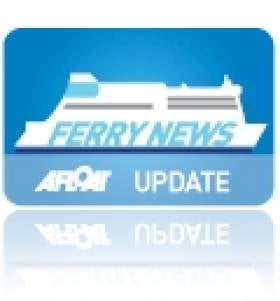Displaying items by tag: DublinDouglas
Due to the pandemic Manx ferry sailings not seen since September 2019, finally resumed on the Dublin-Douglas seasonal service with crossings carried out by a catamaran fastcraft, writes Jehan Ashmore.
The catamaran, Manannan operated by Isle of Man Steam Packet made the outward crossing from the Manx capital to Dublin on the summer service which takes approximately 2 hours 55 minutes.
Resumption of the seasonal operated Irish Sea route follows the Manx Government's easing of Covid-19 border travel restrictions that became effective from 28th June.
Manannan also operates other seasonal based routes linking the Isle of Man and the UK, mainly running the Douglas-Liverpool link, where today the craft has been kept busy.
In addition the 96m vehicle carrying catamaran built in 1998 by InCat, Tasmania, also serves Douglas-Belfast with the next scheduled sailing to the Ulster city on Sunday. A crossing time of 2 hours 45 minutes is advertised, though some sailings run by the conventional ferry, Ben-My-Chree involves a more leisurely passage of almost five hours.
As for the Manannan's next return to Dublin, this is to take place on Tuesday, 20th July, with a departure from Douglas of 07.00hrs. A corresponding departure from Dublin by the fastcraft is at 10.45hrs with an arrival in Douglas during lunch-hour.
While Manannan's roster sees the fastcraft running on several routes, the Ben-My-Chree is mostly concentrated on the year round Douglas route to Heysham in north-west England.
The ageing ferry last month returned to service following longer delays due to unforeseen issues while dry-docking on Merseyside.
As Afloat previously reported, around 31,600 passengers have booked to travel on Steam Packet vessels during July, 16,955 of which are due to sail on board the Manannan.
Manannan was introduced in 2009, whereas Ben-My-Chree dating to 1998, is however to be replaced by a larger custom-built ro-pax due to enter service in 2023. The newbuild is to be named Manxman.
Final Manx-Dublin Seasonal Service Sailings
#ISLE OF MAN FERRY – This weekend will see the final round-trip of seasonal Douglas-Dublin sailings operated by the Isle of Man Steam Packet Company.
The ro-pax ferry Ben-My-Chree is scheduled to depart Douglas tomorrow evening at 19.30hrs with an arrival in Dublin Port on (Sunday30 December) just after midnight at 00.15hrs.
The ferry will make her return departure to the Isle of Man, departing Dublin Ferryport at 01.00hrs with an arrival at the Manx capital scheduled for 05.45hrs.
For sailing schedules including Manx-UK routes, click HERE.
Bank Holiday Marks Start of Manx Sailings
#ISLE OF MAN FERRY – This Easter bank holiday weekend marks the start of the Isle of Man Steam Packet Co.'s seasonal-only Dublin-Douglas ferry service, with a sailing scheduled to depart this evening, writes Jehan Ashmore.
The wave-piercing catamaran fastcraft Manannan had departed the Manx capital this afternoon to form the inaugural outbound sailing, which takes nearly three hours to complete. The 96m fastcraft is the largest of her type in the Irish Sea and she was built by InCAT in Hobart, Tasmania. She also maintains sailings on the Douglas to Belfast and Liverpool routes.
For sailing timetables across the network of routes to the Isle of Man click HERE and for a guide about the fastcraft and conventional ferry Ben-My-Chree click this LINK.
Ferry Changes on Dublin-Isle of Man Route
#FERRY NEWS- This weekend's round-trip Douglas-Dublin sailings are to be served by fast-ferry Manannan (1998/5,743grt) instead of conventional ferry, writes Jehan Ashmore.
Usually these winter sailings are operated by Ben-My-Chree (1998/12,504grt), as the Dutch built ro-pax is in dry-dock at Cammell Laird, Birkenhead for repairs to her bow-thruster.
The InCAT built Manannan will cover these sailings with an arrival in Dublin Port this evening at 22.00hrs. She spends a short-around in port lasting only 45 minutes, before returning to the Manx capital.
Manx Seasonal Visitor to Dublin Port
Following this mornings Irish route sailing, she resumed on her regular Douglas-Heysham route and she also serves Douglas-Birkenhead (Liverpool) during the winter months.
During the summer Dublin-Douglas sailings are served by fast-ferry catamaran Manannan (1998/5,743grt). The 96m InCAT built in Hobart,Tasmania had also operated Douglas-Belfast high-season crossings. Her roster is now confined to a Douglas-Liverpool sailing schedule.
Ben-My-Chree (photo) is Manx for 'Girl of my heart' and her island owners commissioned the 12,504grt ro-pax from Dutch shipbuilders Van de Giessen-de Noord. The 125m ferry was launched in 1998 and she can accommodate 630 passengers,275 vehicles and 1,235 freight lane-metres.
This particular ro-pax design has also been built for Channel Islands operator Commodore Ferries with their Commodore Clipper and a Scandinavian ferry operator. In addition another Dutch shipbuilder, Merwede built a multi-support vessel (MRV) derived from the design of Ben-My-Chree for the Royal New Zealand Navy when they commissioned HMNZS Canterbury (L421). Click for similar port-side photo view to compare differences.
Incidentally the Manannan prior to entering service last year for the IOMSPCo. was for five years chartered initially to the United States Navy but transferred to the United States Army Forces. To read more click HERE.




























































